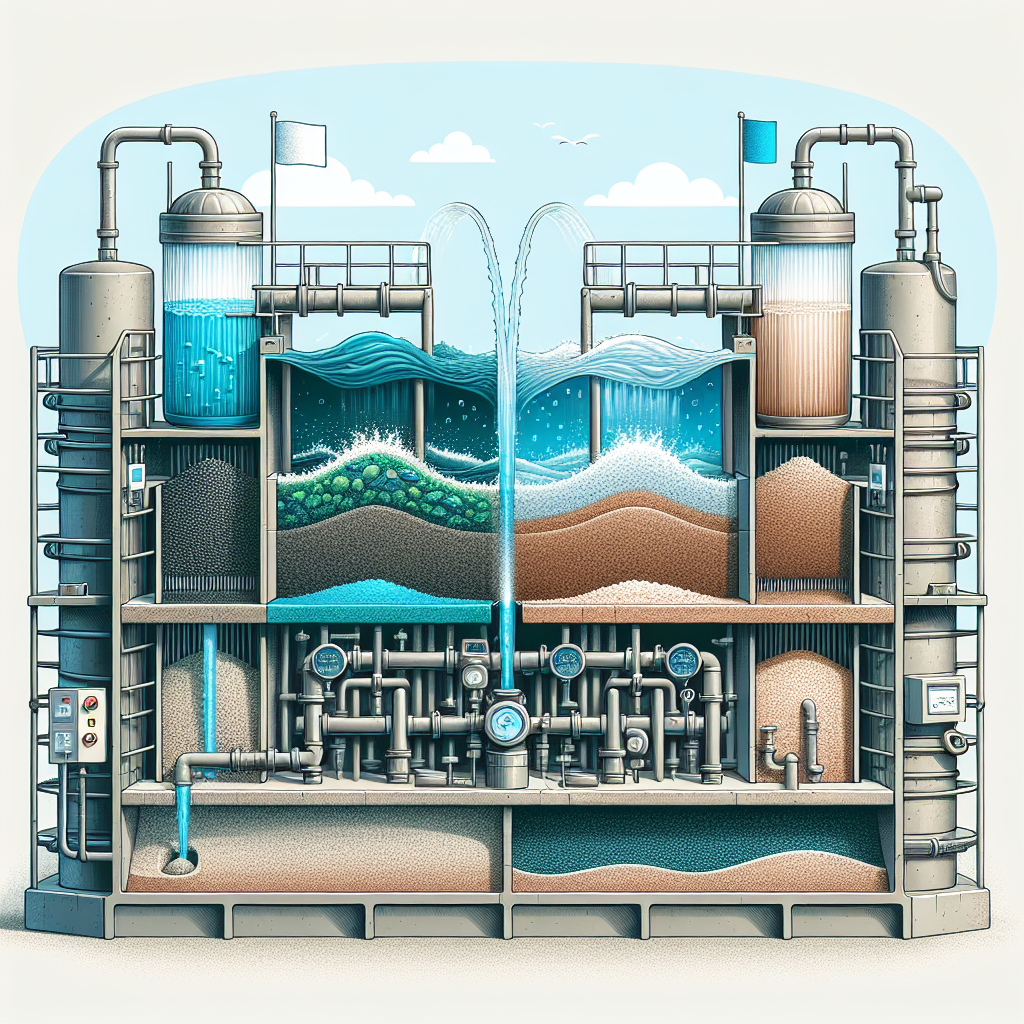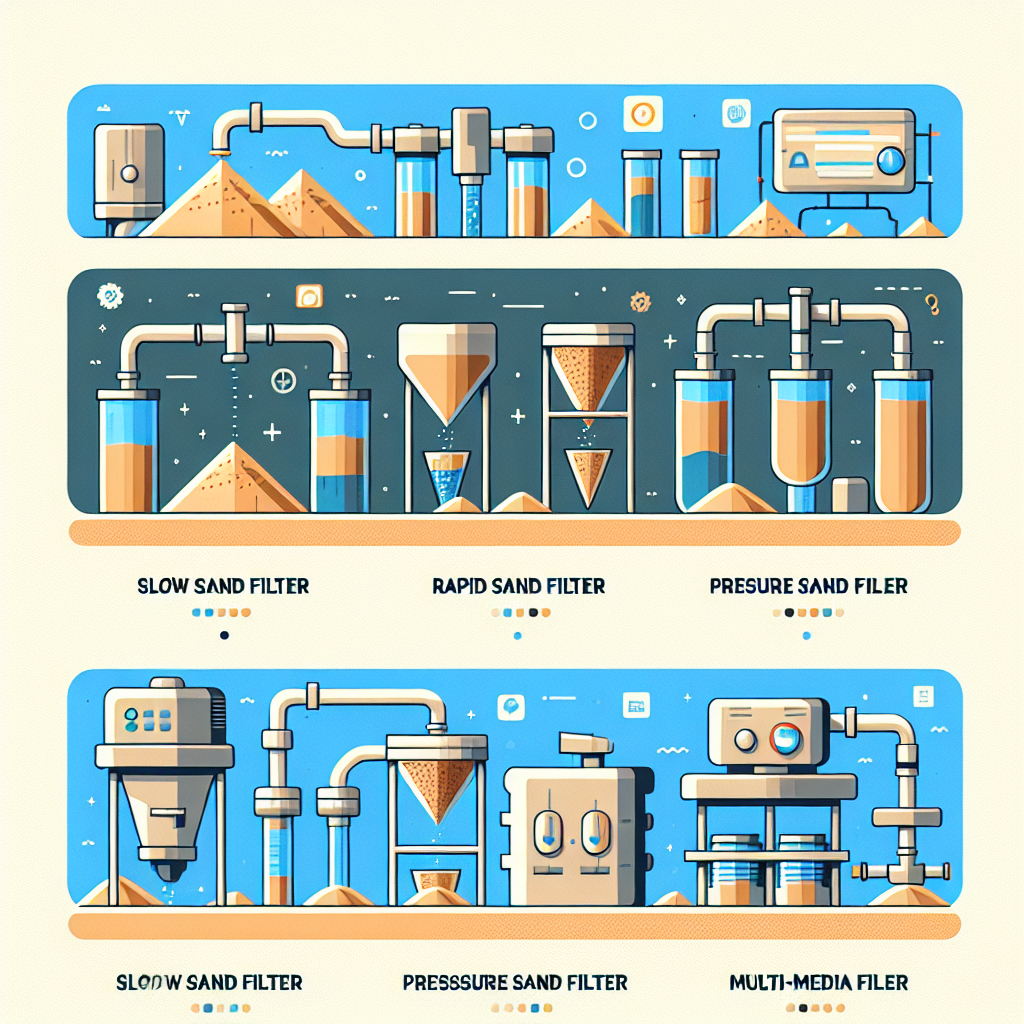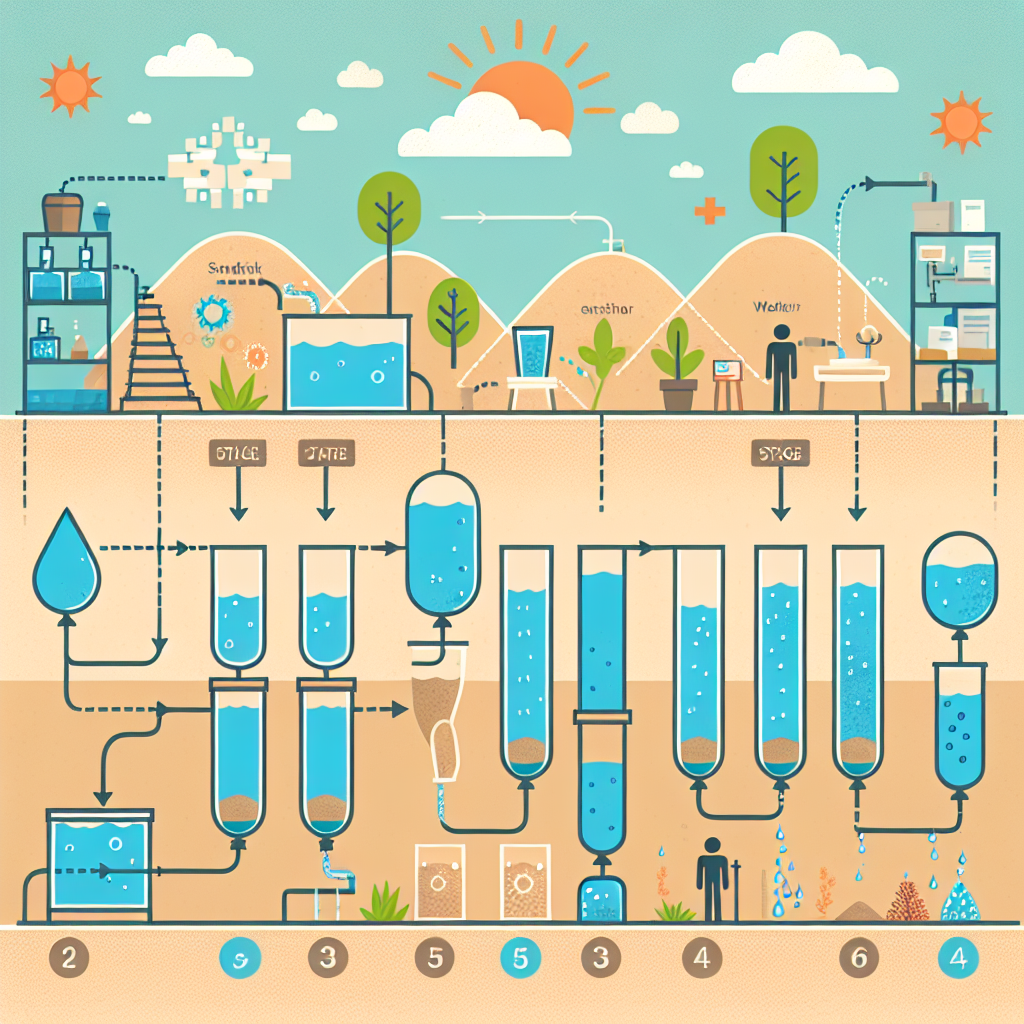Sand Filtration Systems: The Cornerstone of Water Treatment

Sand Filtration Systems: The Cornerstone of Water Treatment
Introduction
Welcome to the world of sand water filtration, where grains of sand play a heroic role in the quest for clean drinking water! If you thought filtration was just about fancy gadgets and high-tech solutions, think again. We’re diving into the gritty details of how these humble grains can transform murky water into a refreshing elixir.
In an era where water quality is more crucial than ever, understanding water purification methods is essential. From municipal waste management facilities to agricultural applications, sand filtration systems are the unsung heroes behind many successful water treatment methods. Whether it’s a slow sand filtration system or a rapid sand filter, these systems are designed to tackle various contaminants and improve overall water quality.
But wait, there’s more! Sand filters aren’t just for big cities or industrial use; they can also be your DIY best friend. Imagine crafting your very own homemade sand filter for your garden pond or well water filtration system! With minimal investment and some elbow grease, you can tap into sustainable practices that echo nature’s own natural water filtration techniques.
So buckle up as we explore the fascinating world of sand filters where simplicity meets efficiency and sustainability reigns supreme. Get ready to uncover the secrets of sediment removal filters, discover the benefits of using silica sand filter media, and learn how to keep your sand filters in tip-top shape with proper maintenance!
Understanding Sand Water Filtration
Let’s dive into the sandy depths of sand water filtration, shall we? At its core, this method harnesses the natural properties of sand to filter out impurities from water. Think of it as nature’s very own coffee filter, but instead of brewing a cup of joe, it’s serving up clean drinking water!
A sand filtration system is designed to remove suspended solids and contaminants, making it a crucial player in the world of water purification. Whether you’re dealing with the murky waters of a pond or just trying to ensure your well water is safe, sand filters are here to help.
Did You Know? Sand filtration has been used for thousands of years! Ancient civilizations recognized its effectiveness long before modern technology came along.
The Importance of Sand Water Filtration
In a world where clean drinking water is becoming increasingly scarce, understanding and implementing efficient water treatment methods like sand filtration is crucial. Not only does it help in removing sediment and pathogens, but it also enhances the overall quality of water. This is especially vital for municipalities and industries where maintaining high standards for potable and process water is non-negotiable.
Moreover, sand filters are typically low-maintenance compared to other filtration systems. They can handle large volumes of water without breaking a sweat perfect for everything from municipal waste management facilities to agricultural applications. So whether you’re looking at a simple DIY sand filter for home use or an industrial setup, this method stands tall as one of the most reliable options available.
Types of Sand Filters
- Slow Sand Filtration: Ideal for small-scale applications where the flow rate isn’t critical.
- Rapid Sand Filter: Perfect for treating large volumes quickly think municipal plants!
- Pressure Sand Filter: Utilizes pressure to push water through the sand media, speeding up the process even more.
- Multi-Media Filters: Combine different types of media (like activated carbon) with sand for enhanced filtration capabilities.
The versatility and effectiveness of these systems make them invaluable in various contexts from treating river water using advanced river water filtration techniques to ensuring that pool sand filters keep our aquatic havens crystal clear!
Types of Sand Filtration Systems
When it comes to sand water filtration, not all filters are created equal. Each type serves different purposes, and understanding these can help you choose the right system for your needs. Let’s dive into the four main types of sand filtration systems that are making waves in water treatment!
1. Slow Sand Filtration
Slow sand filters are like the tortoises of the filtration world: they take their time but do an excellent job at it! Water flows slowly through a bed of sand, allowing natural biological processes to break down contaminants. This method is particularly effective for drinking water filtration and is often used in rural areas where access to modern technology is limited.
2. Rapid Sand Filter
If slow sand filters are tortoises, then rapid sand filters are the hares! These systems work quickly, using a coarser sand media that allows for faster water flow. They’re commonly found in municipal water treatment plants due to their efficiency in handling large volumes of water. However, they require more frequent backwashing and maintenance compared to their slower counterparts.
3. Pressure Sand Filter
Imagine a soda can under pressure; that’s kind of what happens here! In pressure sand filters, water is forced through a bed of sand under pressure, making them compact and efficient. They’re often used in industrial settings or for treating well water because they can handle high flow rates and effectively remove sediments.
4. Multi-Media Filters
This is where things get fancy! Multi-media filters combine various types of filter media (like gravel, silica sand, and activated carbon) to tackle multiple contaminants at once. They’re great for complex water sources such as rivers or ponds, where different pollutants might be lurking around every corner.
The Water Filtration Process
So, how does this magical sand water filtration work? Buckle up, because we’re diving into the nitty-gritty of the water filtration process! Whether you’re dealing with a slow sand filtration system or a speedy rapid sand filter, the core principles remain the same.
How Sand Filters Work
At its core, a sand filter is like a bouncer at an exclusive club it only lets in the good stuff! As water flows through layers of specially graded sand (think of it as nature’s very own sieve), contaminants and impurities are trapped, ensuring that only clean water makes it to the other side. This process is not just about catching big particles; it’s also about biological processes that occur within the filter media.
Stages of the Water Filtration Process
- Pre-treatment: Here, larger debris like leaves and sticks are removed. This stage is crucial for preventing clogs in your sand filter.
- Sediment Removal: As water enters the sand layer, sediment and larger particles get stuck in the top layers. Gravity does its thing, pulling water down through finer grains.
- Biological Filtration: In slow sand filters, a biofilm develops on top of the sand layer. This film is made up of beneficial microorganisms that feast on organic matter talk about a win-win!
- Purification: The final stage ensures that any remaining impurities are captured before clean drinking water emerges. It’s like giving your water a spa day!
Sediment Removal Techniques
Sediment removal is where things get interesting! Different techniques can be employed depending on the system in use:
- Backwashing: For rapid and pressure sand filters, backwashing is essential. This involves reversing the flow of water to flush out trapped sediments.
- Dredging: In some cases, especially with homemade or DIY sand filters, you might need to manually remove layers of contaminated sand and replace them with fresh media.
- Chemical Aids: Some advanced systems use coagulants to help clump together smaller particles so they can be filtered out more efficiently.
This entire process not only enhances your drinking water quality but also plays a vital role in sustainable practices across various sectors including agriculture and municipal waste management. So next time you sip that refreshing glass of H2O, you can appreciate all the hard work happening behind the scenes!
Sand Filter Maintenance and Care
Keeping your sand water filtration system in tip-top shape is essential for optimal performance and longevity. Think of it as giving your filtration system a spa day after all, it works hard to provide you with clean, safe water!
Routine Maintenance Practices
Regular maintenance can prevent minor issues from turning into major headaches. Here are some key practices to consider:
- Backwashing: This is your sand filter’s version of a refreshing rinse! Regular backwashing helps remove accumulated debris and keeps the filter media clean.
- Checking Pressure Gauges: Keep an eye on those pressure gauges! If the pressure is significantly higher than normal, it might be time for a backwash or media replacement.
- Inspecting Valves and Fittings: Look out for leaks or wear and tear. A little inspection goes a long way in preventing bigger issues down the line.
Troubleshooting Common Issues
If you encounter problems, don’t panic! Here’s how to troubleshoot some common sand filter issues:
- Cloudy Water: This could indicate that your sand filter isn’t doing its job properly. Check for clogs or consider replacing the sand filter media.
- Unusual Odors: If something smells funky, it could be time to inspect your system for organic buildup or contamination.
- Poor Water Flow: A reduction in flow can signal blockages in the filter or plumbing. Cleaning out any debris should do the trick!
Replacement of Sand Filter Media
Your filter media is like a trusty sidekick it needs to be replaced periodically to maintain efficiency. Here’s how to know when it’s time for a refresh:
- If backwashing doesn’t improve performance after several attempts, it’s likely time for a change.
- A noticeable drop in water quality can also signal that your silica sand filter needs new media.
- A good rule of thumb? Replace the sand every 3-5 years, depending on usage and water quality conditions.
Takeaway: Regular maintenance not only extends the life of your sand filtration system but also ensures that you get the best possible water quality improvement from your setup!
Benefits of Using Sand Filters in Water Treatment
When it comes to sand water filtration, the benefits are as plentiful as grains of sand on a beach. Let’s dive into why these systems are the unsung heroes of water treatment!
-
Efficacy in Sediment Removal and Water Quality Improvement
Sand filters excel at removing sediments, making them a cornerstone in the water filtration process. Whether you’re dealing with murky pond water or tap water that tastes like a swimming pool, a sand filter can dramatically enhance clarity and quality. Think of it as your personal bouncer, keeping all the unwanted guests (aka contaminants) out!
-
Sustainability and Eco-Friendliness
In an era where eco-friendly solutions are more critical than ever, sand filters shine brightly. Made from natural materials like silica, they offer a sustainable alternative to chemical-based filtration methods. Plus, they require less energy to operate compared to their high-tech counterparts. It’s like choosing to ride a bicycle instead of driving a gas-guzzler better for you and the planet!
-
Cost-Effectiveness Compared to Other Filtration Methods
Let’s talk dollars and cents! Sand filtration systems are generally more affordable to install and maintain than complex multi-media filters or activated carbon setups. This makes them an attractive option for municipalities looking to improve their drinking water filtration without breaking the bank. Why spend more when you can get efficient results at a fraction of the cost?
-
Versatility Across Applications
From municipal waste management facilities to agricultural sectors needing groundwater filtration, sand filters can adapt like a chameleon! They’re suitable for various applications including industrial water filtration and even DIY setups for home use. Imagine having a reliable solution that works just as well whether you’re filtering well water or managing wastewater!
-
Low Maintenance Needs
Who doesn’t love low-maintenance solutions? With proper care think routine checks and occasional media replacement a sand filter can last for years, providing consistent performance without requiring constant attention. It’s like having that one friend who always shows up on time without needing reminders!
Applications of Sand Filtration Systems in Various Industries
Sand filtration systems are the unsung heroes of water purification, quietly working behind the scenes in various industries to ensure clean, safe water. Let’s dive into how these systems are applied across different sectors like a well-placed sand filter at a pool party essential for a good time!
-
Municipal Waste Management Facilities
In cities bustling with life, municipal waste management facilities utilize sand water filtration to treat wastewater effectively. This process not only removes sediments but also plays a crucial role in meeting regulatory standards for discharged water. Think of it as the bouncer at an exclusive club only the cleanest water gets through!
-
Agricultural Sector Applications
Farmers are increasingly turning to sand filtration systems for irrigation and livestock watering. By using a homemade sand filter or bio-sand filter, they can ensure that their crops receive high-quality water without harmful contaminants. It’s like giving your plants a spa day hydrating them with pure, filtered goodness.
-
Groundwater and Well Water Filtration
For those relying on well water, sand filters can be lifesavers. These systems help in groundwater filtration by removing sediments and impurities, making sure that every glass of water is as refreshing as it should be. Imagine having your very own natural spring right in your backyard!
-
Industrial Water Filtration
Industries like manufacturing and food processing utilize rapid sand filters to maintain operational efficiency. These filters provide quick sediment removal and ensure that machinery operates smoothly without clogging issues. It’s akin to having a pit crew ready at all times keeping everything running without any hiccups.
-
Pond Sand Filter Systems
Pond sand filter systems are also gaining traction for recreational waters and aquaculture. They aid in maintaining clear water by filtering out algae and debris, ensuring aquatic life thrives while providing beautiful scenery for visitors. Think of it as nature’s own little cleaning crew!
-
- < li >Municipal waste management facilities< / li >< li >Agricultural sector applications< / li >< li >Groundwater and well water filtration< / li >< li >Industrial water filtration< / li ></ ul ></ section >





